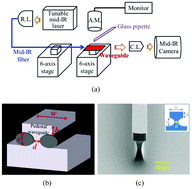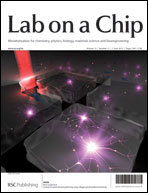Towards a future lab-on-a-chip spectrometer, we demonstrate a compact chip-scale air-clad silicon pedestal waveguide as a Mid-Infrared (Mid-IR) sensor capable of in situ monitoring of organic solvents. The sensor is a planar crystalline silicon waveguide, which is highly transparent, between λ = 1.3 and 6.5 μm, so that its operational spectral range covers most characteristic chemical absorption bands due to bonds such as C–H, N–H, O–H, C–C, N–O, C![[double bond, length as m-dash]](https://www.rsc.org/images/entities/char_e001.gif) O, and C
O, and C![[triple bond, length as m-dash]](https://www.rsc.org/images/entities/char_e002.gif) N, as opposed to conventional UV, Vis, Near-IR sensors, which use weaker overtones of these fundamental bands. To extend light transmission beyond λ = 3.7 μm, a spectral region where a typical silicon dioxide under-clad is absorbing, we fabricate a unique air-clad silicon pedestal waveguide. The sensing mechanism of our Mid-IR waveguide sensor is based on evanescent wave absorption by functional groups of the surrounding chemical molecules, which selectively absorb specific wavelengths in the mid-IR, depending on the nature of their chemical bonds. From a measurement of the waveguide mode intensities, we demonstrate in situ identification of chemical compositions and concentrations of organic solvents. For instance, we show that when testing at λ = 3.55 μm, the Mid-IR sensor can distinguish hexane from the rest of the tested analytes (methanol, toluene, carbon tetrachloride, ethanol and acetone), since hexane has a strong absorption from the aliphatic C–H stretch at λ = 3.55 μm. Analogously, applying the same technique at λ = 3.3 μm, the Mid-IR sensor is able to determine the concentration of toluene dissolved in carbon tetrachloride, because toluene has a strong absorption at λ = 3.3 μm from the aromatic C–H stretch. With our demonstration of an air-clad silicon pedestal waveguide sensor, we move closer towards the ultimate goal of an ultra-compact portable spectrometer-on-a-chip.
N, as opposed to conventional UV, Vis, Near-IR sensors, which use weaker overtones of these fundamental bands. To extend light transmission beyond λ = 3.7 μm, a spectral region where a typical silicon dioxide under-clad is absorbing, we fabricate a unique air-clad silicon pedestal waveguide. The sensing mechanism of our Mid-IR waveguide sensor is based on evanescent wave absorption by functional groups of the surrounding chemical molecules, which selectively absorb specific wavelengths in the mid-IR, depending on the nature of their chemical bonds. From a measurement of the waveguide mode intensities, we demonstrate in situ identification of chemical compositions and concentrations of organic solvents. For instance, we show that when testing at λ = 3.55 μm, the Mid-IR sensor can distinguish hexane from the rest of the tested analytes (methanol, toluene, carbon tetrachloride, ethanol and acetone), since hexane has a strong absorption from the aliphatic C–H stretch at λ = 3.55 μm. Analogously, applying the same technique at λ = 3.3 μm, the Mid-IR sensor is able to determine the concentration of toluene dissolved in carbon tetrachloride, because toluene has a strong absorption at λ = 3.3 μm from the aromatic C–H stretch. With our demonstration of an air-clad silicon pedestal waveguide sensor, we move closer towards the ultimate goal of an ultra-compact portable spectrometer-on-a-chip.
![[double bond, length as m-dash]](https://www.rsc.org/images/entities/char_e001.gif) O, and C
O, and C![[triple bond, length as m-dash]](https://www.rsc.org/images/entities/char_e002.gif) N, as opposed to conventional UV, Vis, Near-IR sensors, which use weaker overtones of these fundamental bands. To extend light transmission beyond λ = 3.7 μm, a spectral region where a typical silicon dioxide under-clad is absorbing, we fabricate a unique air-clad silicon pedestal waveguide. The sensing mechanism of our
N, as opposed to conventional UV, Vis, Near-IR sensors, which use weaker overtones of these fundamental bands. To extend light transmission beyond λ = 3.7 μm, a spectral region where a typical silicon dioxide under-clad is absorbing, we fabricate a unique air-clad silicon pedestal waveguide. The sensing mechanism of our 

 Please wait while we load your content...
Please wait while we load your content...